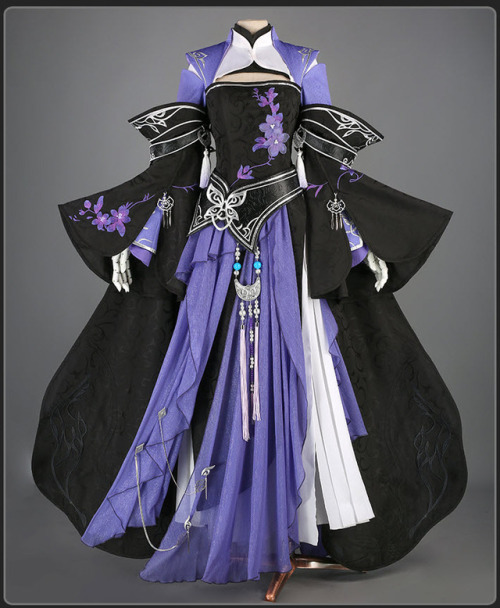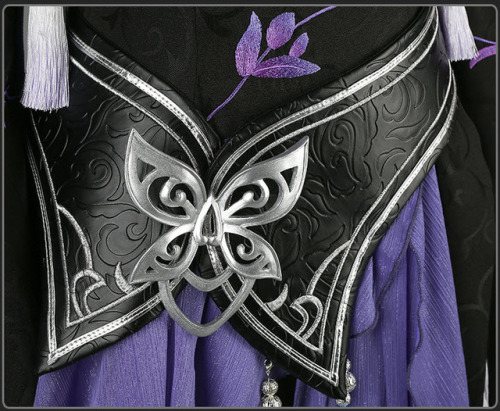The White Magician! The More Wicked And Cruel Of All Of Them!

The white magician! The more wicked and cruel of all of them!
How do you see it guys?
-Facebook: http://on.fb.me/186nDPf
-Deviant: http://bit.ly/1LSw0gv
-Behance: http://on.be.net/1ExGIH9
More Posts from Thejunkdrawers and Others
Cultures/creeds for a gonzo transhuman fantasy setting constructed entirely from repurposed Dungeons & Dragons tropes:
A community of serial reincarnationists under a permanent enchantment that causes them to eventually reappear in a new young adult body with personality and memories intact any time they’re killed, whether through violence, disease or old age. The exact form the new body takes is random, and is as likely to be an animal as a humanoid; their cavalier attitude toward death is tempered by a strong cultural expectation to learn how to live with whatever body you end up with, so it’s not uncommon to encounter - for example - a respected member of the community who currently happens to be an owl. Socially they tend toward agrarianism, though they have no particular objection to urban living; in their ethos, a sprawling city differs from a bird’s nest or a beaver’s dam only in scale.
A mob of undead skeletons obsessed with the transitory nature of existence. Their culture is dominated by short-lived art forms, like sand paintings, improvisational music, and elaborate wooden sculptures which are burned on completion. They’re able to freely swap bones with each other, or replace them with suitably prepared substitutes taken from non-undead skeletons or carved from wood or other dead organic matter, and it’s not uncommon to encounter a skeleton with none of their original bones remaining; pondering the resulting ship-of-Theseus problem with respect to personal identity is regarded as a fun intellectual exercise, but it doesn’t actually bother them. Alone among the creeds, they never directly produce new members; every one of them is a former member of some other creed.
A society devoted to the pursuit of knowledge by transforming life forms through experimental wizardry. They regard experimenting on others - even animals - as horrifyingly unethical, and as a result, each of them uses their own body as a testing ground. Individual members range from mostly human with only a few odd physical quirks, to entities not readily recognisable as life, let alone people. While novel transmutations are always self-directed, they’re willing to perform the most thoroughly tested and proven procedures on others with informed consent, a service that comes in high demand. Likewise, interventions to rescue other members of the creed from experiments gone awry are permitted, though only after careful deliberation - after all, perhaps your neighbour meant to spend a year as a rock!
catopumas are so interesting 2 me bc theres only two species so far in the genus, and its either
a very gentle looking asian golden cat


very kind looking, round. 10/10
and then the other in the genus is


the bay cat, or as i like to call them - the weasel cat. long, kinda weird looking, but still 10/10 despite the weaselness.
Foods Humanity Figures Out Everywhere
soup: Boil The Food To Make Food Water
stew? gravy? curry?: like soup but less water more food
porridge: add water to the starch but not so much. warm and mushy yum
pancake/flatbread: make the starch wet and flat, then put on hot surface.
fried starch thing: Use hot oil to make starch crispy yum++
dumpling: put the not starch in the starch thing and cook it.
alt dumpling: ball of starch added to soup or stew. makes chewy starch ball yum yum
filled portable food: starch wrapper of some kind to make it so you can eat the messy food with your hands.
And speaking of scurvy, I am eternally amused by the thing where some ancient form of healing that was born in a time where people didn't know exactly how the human body works, or what causes it to stop working sometimes, that still somehow worked. Like how so many old folk medicinal plants were listed as a cure for various ailments that - from a modern view - are clearly just symptoms of scurvy, and the plant itself is rich in vitamin C.
I recall reading some story, no recollection of the exact time or place, where the king of a large empire suffered from constant horrible headaches and was incapable of falling asleep unless drugged or blackout drunk. Sick of taking temporary fixes to dull the pain and having to be sedated every night, he called up some old sage healer who was said to know how to fix things nobody else could explain, and the healer heard his symptoms and went
"Hmm. You spend too much time being a king. Your skull is packed so full of kingly thoughts that they don't all fit in there and that's why your head is in pain. You need to spend time not being a king." And prescribed him to schedule three days every month where he must go to a peasant village where nobody knows he's the king, live with a family there under a fake name and identity, work in the rice fields with them, eating the same food and sleeping on the same mats. Absolutely nobody is allowed to address him as the king, speak to him of any royal or political matters, and he himself is not allowed to think any kingly thoughts or think of himself as the king.
And naturally, this worked. Taking a regular scheduled break from a highly stressful office desk job to completely decompress, paired with physical exercise in the form of hard but simple physical labour, plain and simple food and Just Not Thinking About Your Fucking Job All The Time does help chronic stress, which here was worded as "spending too much time being a king clogs your brain."
Sometimes you do have ghosts in your blood, though I'm not entirely sure whether you should do cocaine about it.
Social Insects in Science Fiction
Hello, my name is Poetry, and I love social insects. Whether they’re ants, bees, termites, wasps, aphids, thrips, or ambrosia beetles, I find them fascinating to learn about. But if the sci-fi books I read as a kid had had their way, I should have run screaming from every ant colony I saw.
From the buggers in Ender’s Game to the Borg in Star Trek to the Vord in Codex Alera to ants and termites themselves from a morph’s-eye view in Animorphs, social insects, and the aliens or artificial intelligences that closely resemble them, are portrayed as “hive minds” with an emotional tone of existential terror. And I’m here to tell you that these portrayals are totally unfair.
What they get right
Here are some features that most portrayals of social insects and their analogues in sci-fi get right. Yes, social insect colonies have queens that are primarily responsible for reproduction. Yes, social insects have very different sensory modalities from ours. We primarily use sight and sound to communicate and navigate the world, while social insects use taste and smell and vibration. Yes, social insects have specialized division of labor to particular tasks, and yes, they are willing to sacrifice themselves in droves to protect the colony. And sometimes, they will enslave social insects from other colonies or even species to serve their own ends (x).
Thus ends what sci-fi portrayals get right.
What they get wrong: Queens
Almost universally in sci-fi, when you kill the queen, the hive disintegrates into chaos. You’ve cut off the head! The central intelligence of the hive is gone! They’re just mindless borg-units with no idea what to do!
Indeed, in some social insects, such as leafcutter ants, if you kill the queen, the whole colony will die – but probably not for the reasons you think. However, it’s more common for social insects to be able to carry on just fine regardless. In most ants and bees, there are “backup” queens that are reared up by the workers in case the current queen should die. And in many social insects, a worker can step up and become a queen in her place. (Hilariously, a worker ant that steps up to reproduce in place of a queen ant is called a gamergate.)
But here is the most important problem with the sci-fi trope of killing the queen to kill the hive. The queen is not the brain of the hive. She is the ovary.
If you think of a social insect colony as a superorganism, which it’s useful to do in many cases, different groups of insects within the colony act like organs. One caste protects the colony from invaders, which is like an immune system. One caste scouts for new places to forage, which is like a sensory system. Generally, science fiction has a good grip on this idea. Where sci-fi authors fail is that they think the queen is the brain of this superorganism. She is not. She is the reproductive system. The queen does not control what happens in the hive any more than your reproductive system controls what happens in your body. (Which is to say, she has some influence, but she is not the brains of the operation.)
The reason why leafcutter ant colonies die when the queen dies is because the colony has been castrated, not beheaded. Most animals die when they are no longer able to reproduce, even if their brains are still perfectly functional. For castrated colonies with no backup queen or gamergate and no hope of getting one, there is no point in carrying on. Their evolutionary line has ended.
What they get wrong: Swarm intelligence
Here is how social insect hive minds work in science fiction: the queen does the thinking, and the rest of the hive goes along with whatever she thinks.
Now, I’ve already told you that the queen is not the brain of the hive. So where is the brain? Well, that is exactly the point of swarm intelligence. The brain does not reside in one particular animal. It’s an emergent property of many animals working together. A colony is not like your body, where your brain sends an impulse to your mouth telling it to move, and it moves. It’s more like when two big groups of people are walking toward each other, and they spontaneously organize themselves into lanes so no one has a collision (x). There’s no leader telling them to do that, but they do it anyway.
Much of the efficiency of social insect colonies comes from very simple behavioral rules (x). Hymenopterans, the group of insects that includes ants, bees, and wasps, have a behavioral rule: work on a task until it is completed, and when it is done, switch to a different task. If you force solitary bees (yes, most bee species are solitary) to live together, they will automatically arrange themselves into castes, because when one bee sees another bee doing a task like building the nest, its behavioral rule tells it that the task is completed and it needs to switch to a different task, like looking for food.
Individually, a social insect isn’t all that smart, whether it’s a queen, worker, soldier, or drone. But collectively, social insects can do incredibly smart things, like find the most efficient route from the colony to some food (x), or choose the perfect spot to build their hive (x).
What they get wrong: Individuality
The existential terror of the hive mind in science fiction comes from the loss of the self. The idea is that in a social insect colony, there is no individual, but one whole, united to one purpose. No dissent, disagreement, or conflicting interests occur, just total lockstep. I totally get why that’s scary.
The thing is, it’s just not true of real social insects. There is conflict within colonies all the time, up to and including civil war.
A common source of conflict within colonies is worker reproduction. Yes, in most social insects, workers can in fact reproduce, though usually they can only produce males. So why don’t they? Because it’s not in the interest of their fellow workers. Workers are more closely related to their siblings and half-siblings produced by the queen than they are to their nephews, so they pass on more of their genes if they spend resources on raising the queen’s eggs. So, if a worker catches its fellow laying an egg, it will eat the egg. Not exactly “all for one and one for all,” is it?
Worker insects may also fight in wars of succession. If there is more than one queen in a species where queens do not tolerate each other (yes, there are species where multiple queens get along together just fine), such as monogynous fire ants, the workers will ally themselves with one queen or another and engage in very deadly civil war.
Finally, in some species, the queen needs to bully the workers into doing their jobs, and the dominant workers need to bully subordinate workers into doing their jobs (x). Yes, sometimes workers try to laze around and mooch.
Surprisingly human
Here’s what I find weird about depictions of social insects in science fiction. They are portrayed as utterly alien, Other, and horrifying. Yet humans and social insects are very, very similar. The famous sociobiologists E.O. Wilson and Bernard Crespi have both described humans as chimpanzees that took on the lifestyle of ants.
I think what fascinates people, including me, about ants, bees, and their ilk is that you watch, say, a hundred ants working together to tear up a leaf into tiny bits and carry it back to their colony, or a hundred bees all appearing out of seemingly nowhere to sacrifice themselves en masse to stop a bear from eating their hive, and it looks like magic. It really does look like some kind of overmind is controlling their collective actions.
But imagine you’re an alien who comes to Earth, and you know nothing about humans or the way we communicate. Wouldn’t we look exactly the same to them as ants and bees look to us? Wouldn’t they look at us sacrificing our lives by the thousands in wars, or working together to build cities from nothing, and think, Wow, how do they coordinate themselves in such huge numbers, why do they give up their lives to defend their borderlines, I guess there must be some kind of mega-brain they all share that tells them what to do, and they just march in lockstep and do it.
If there’s anything I’ve learned from the study of both social insects and humans, it’s that any system that looks monolithic and simple from a distance is in fact fractured, messy, and complicated when you look at it up close.
Social insects aren’t scary mindless robot-aliens. They’re a lot like you and me. As much as I was terrified as a kid by the Animorphs book where an ant morphs into Cassie and screams in pure existential horror at its sudden individuality, I actually think an ant would adjust very easily to being a human, and that a human would adjust very easily to being an ant – much more easily, in fact, than humans adjusted to morphing, say, sharks, in the very same book series.
-
 thejunkdrawers reblogged this · 2 months ago
thejunkdrawers reblogged this · 2 months ago -
 ghostshard reblogged this · 5 years ago
ghostshard reblogged this · 5 years ago -
 soulfularts liked this · 8 years ago
soulfularts liked this · 8 years ago -
 mackenziereblogs reblogged this · 8 years ago
mackenziereblogs reblogged this · 8 years ago -
 alesiabee liked this · 8 years ago
alesiabee liked this · 8 years ago -
 zelsperations reblogged this · 9 years ago
zelsperations reblogged this · 9 years ago -
 thebush94point3-blog liked this · 9 years ago
thebush94point3-blog liked this · 9 years ago -
 molecular-despot liked this · 9 years ago
molecular-despot liked this · 9 years ago -
 midnightsillyhour liked this · 9 years ago
midnightsillyhour liked this · 9 years ago -
 thedrawingbirb liked this · 9 years ago
thedrawingbirb liked this · 9 years ago -
 scarfofsilver liked this · 9 years ago
scarfofsilver liked this · 9 years ago -
 2002-toyota-camry liked this · 9 years ago
2002-toyota-camry liked this · 9 years ago -
 infinitetesimally reblogged this · 9 years ago
infinitetesimally reblogged this · 9 years ago -
 sepulchretide reblogged this · 9 years ago
sepulchretide reblogged this · 9 years ago -
 twisted-persona reblogged this · 9 years ago
twisted-persona reblogged this · 9 years ago -
 lambitymoon reblogged this · 9 years ago
lambitymoon reblogged this · 9 years ago -
 kargaka liked this · 9 years ago
kargaka liked this · 9 years ago -
 lanternowl liked this · 9 years ago
lanternowl liked this · 9 years ago -
 sleepymisfit reblogged this · 9 years ago
sleepymisfit reblogged this · 9 years ago -
 randomizedred reblogged this · 9 years ago
randomizedred reblogged this · 9 years ago -
 inspireceu liked this · 9 years ago
inspireceu liked this · 9 years ago -
 bevydev reblogged this · 9 years ago
bevydev reblogged this · 9 years ago -
 zachsgotyourback liked this · 9 years ago
zachsgotyourback liked this · 9 years ago -
 lavoszero reblogged this · 9 years ago
lavoszero reblogged this · 9 years ago -
 scrapbeast liked this · 9 years ago
scrapbeast liked this · 9 years ago -
 dazedreamatom liked this · 9 years ago
dazedreamatom liked this · 9 years ago -
 drawing-attempt liked this · 9 years ago
drawing-attempt liked this · 9 years ago -
 kaijuvsgiantrobotsvsme liked this · 9 years ago
kaijuvsgiantrobotsvsme liked this · 9 years ago -
 ellengton liked this · 9 years ago
ellengton liked this · 9 years ago -
 microstat reblogged this · 9 years ago
microstat reblogged this · 9 years ago -
 freakshowfox reblogged this · 9 years ago
freakshowfox reblogged this · 9 years ago -
 fernandojam reblogged this · 9 years ago
fernandojam reblogged this · 9 years ago -
 fernandojam liked this · 9 years ago
fernandojam liked this · 9 years ago -
 ecnomoda liked this · 9 years ago
ecnomoda liked this · 9 years ago -
 bootlegpaladin liked this · 9 years ago
bootlegpaladin liked this · 9 years ago -
 composerlost liked this · 9 years ago
composerlost liked this · 9 years ago -
 polehomo liked this · 9 years ago
polehomo liked this · 9 years ago -
 edgepopesupreme reblogged this · 9 years ago
edgepopesupreme reblogged this · 9 years ago -
 edgepopesupreme liked this · 9 years ago
edgepopesupreme liked this · 9 years ago -
 hypnalogue reblogged this · 9 years ago
hypnalogue reblogged this · 9 years ago -
 hypnalogue liked this · 9 years ago
hypnalogue liked this · 9 years ago -
 ive-got-tylenol-and-beer reblogged this · 9 years ago
ive-got-tylenol-and-beer reblogged this · 9 years ago -
 ive-got-tylenol-and-beer liked this · 9 years ago
ive-got-tylenol-and-beer liked this · 9 years ago -
 soundsnotstr8 reblogged this · 9 years ago
soundsnotstr8 reblogged this · 9 years ago -
 whimsicallymacabre liked this · 9 years ago
whimsicallymacabre liked this · 9 years ago

A side blog where I'll *try* to keep things organised.yeahthatsnotgoingtolastlong
241 posts




















